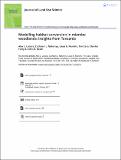| dc.description.abstract | Understanding the drivers of natural habitat conversion is a major challenge,
yet predicting where future losses may occur is crucial to preventing
them. Here, we used Bayesian analysis to model spatio-temporal
patterns of land-use/cover change in two protected areas designations
and unclassified land in Tanzania using time-series satellite images. We
further investigated the costs and benefits of preserving fragmenting
habitat joining the two ecosystems over the next two decades. We reveal
that habitat conversion is driven by human population, existing land-use
systems and the road network. We also reveal the probability of habitat
conversion to be higher in the least protected area category.
Preservation of habitat linking the two ecosystems saving 1640 ha of
land from conversion could store between 21,320 and 49,200 t of carbon
in the next 20 years, with the potential for generating between US$
85,280 and 131,200 assuming a REDD+ project is implemented. | en_US |

